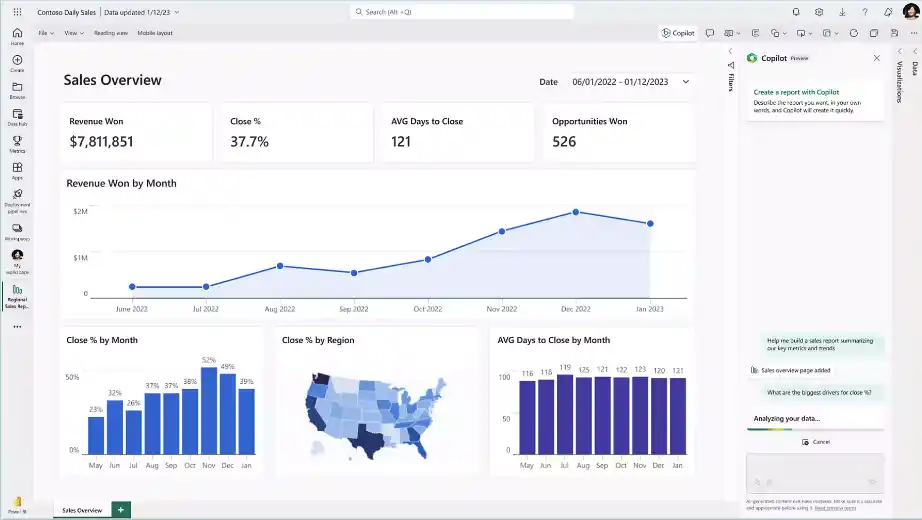Microsoft Fabric: The New End-to-End Analytics Platform
Microsoft just launched their new comprehensive analytics platform, Microsoft Fabric, designed to revolutionize the way organizations harness the...
4 min read
cloudservuscom Sep 19, 2023 2:42:11 PM

It’s more important than ever today for businesses to make data-driven decisions. But while 90% of organizations indicate that data is increasingly critical to their business, just 25% of them indicate that their decisions are driven by data.
Businesses need every available advantage to exploit the potential and value of their data, including data analytics tools that streamline how they collect, analyze, interact with, and visualize data so they can accelerate the journey to trusted, actionable intelligence.
Microsoft Fabric and Power BI are two popular data analytics tools that can help organizations get the most from their data and lay the groundwork for success in the AI era.
Microsoft Fabric is an experience-based, end-to-end analytics platform designed to empower users to access, manage, and operationalize data and insights and collaborate holistically. Power BI is a unified, advanced, and scalable platform built around the concept of self-service that provides interactive visualizations, dashboards, and reports for optimized BI.
But which is the best data analytics tool for your needs?
The recently launched Microsoft Fabric is an integrated, AI-fueled suite of tools and services developed on OneLake, Microsoft’s multi-cloud data lake. The unified architecture provides a Software-as-a-Service (SaaS) experience and full-service capabilities to streamline how businesses pull insights from raw data.
The best way to think about Microsoft Fabric is as a holistic, flexible solution for data storage, management, and analytics. It’s like the thread stitching all of your data and analytics workflow layers together.
Microsoft Fabric contains seven core workloads that are developed to work alongside one another: Synapse Data Science, Synapse Data Warehousing, Data Factory, Data Activator, Synapse Real-Time Analytics, Synapse Data Engineering, and Power BI.
Power BI is a self-service enterprise BI platform that provides user-friendly tools and interfaces for data aggregation, analysis, visualization, and reporting. It offers a real-time view of business data via interactive dashboards to help users collaborate and share insights without compromising consistency, security, and accuracy.
The best way to think about Power BI is as a data visualization tool for transforming data from various sources, like Excel, Azure, or SQL servers, into reports and dashboards for immersive insights. It’s like a storyteller that crafts raw data into a compelling narrative.
Keep in mind that though it’s a component of Microsoft Fabric, Power BI also functions as a stand-alone product.
The flexibility of these tools means that they’re suitable for a variety of use cases, with occasional overlap.
But in a nutshell, Microsoft Fabric is a strong solution for backend data management and prep. It can be used to streamline data integration, manage large quantities of structured data, drive real-time analytics, and enable trusted predictions.
Power BI is more tailored for data visualization and analysis to drive business insights. It can be used for data visualization and analytics, communicating insights, and tracking trends.
|
Feature |
Microsoft Fabric |
Power BI |
|
Type of tool |
End-to-end data and analytics platform |
Data visualization and BI reporting platform |
|
Purpose |
|
|
|
Architecture |
Developed on OneLake, a storage layer that allows data to be stored in an open-source, delta lake format that can support every workload. |
Developed on top of Azure and part of Microsoft’s Power Platform of low-code tools, including Power Pages, Power Automate, Power Apps, and Power Virtual Agents. |
|
Components |
|
|
|
User |
Any data professional or practitioner, including regular business users. |
Regular business users, business analysts, business decision-makers. |
|
Security |
Designed around one security model for centralized data management, security, and governance. |
Designed for granular access control, with features like role-based access control (RBAC), data lineage, and sensitivity labels. |
Each of these tools is independently robust, but keep in mind that they’re intentionally built to be used cohesively for a more complete data analytics solution.
If you’re wondering what the impact of the Microsoft Fabric ecosystem is on Power BI given that the latter is now integrated into Microsoft Fabric as one of the seven core workloads, stay tuned - our upcoming blog will discuss the complete dynamics of this integration for existing Power BI users.
As always, CloudServus is here to help you make the most of your Microsoft environment and tools. We’re an industry-awarded, top 1% Microsoft consultancy with dedicated experts that can help you leverage Microsoft Fabric and Power BI to optimize your end-to-end analytics journey and Microsoft investments.
From developing a strategy for implementation and integration to knowledge transfer and ongoing maintenance, our team provides a turn-key approach tailored to improve your unique Microsoft experience.
Contact us at CloudServus if you have any questions about Microsoft Fabric and Power BI or want to get a jump start with these comprehensive analytics solutions.

Microsoft just launched their new comprehensive analytics platform, Microsoft Fabric, designed to revolutionize the way organizations harness the...

For all of you out there wondering what the freshly launched Microsoft Fabric means if you’re already using Power BI, stay put.

As Microsoft rolls out its comprehensive analytics platform, Microsoft Fabric, existing Power BI users face a pivotal moment of transition. This...